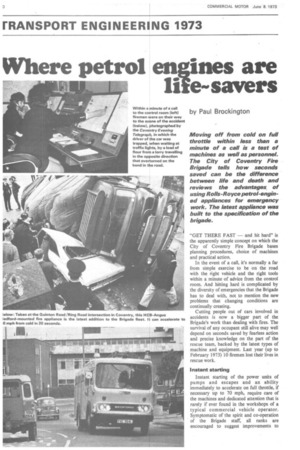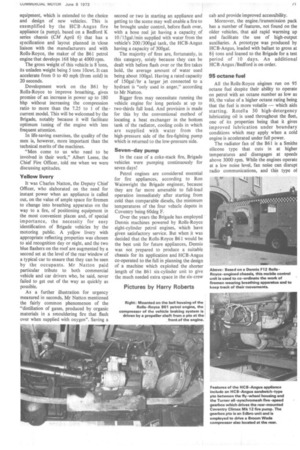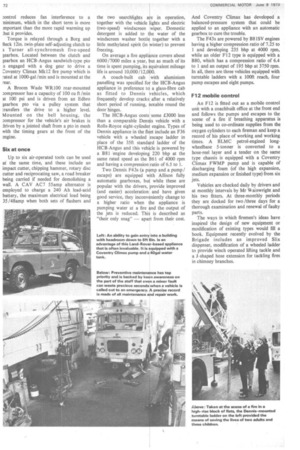Where petrol engines are Mee savers
Page 72

Page 73

Page 74

If you've noticed an error in this article please click here to report it so we can fix it.
by Paul Brockington
Moving off from cold on full throttle within less than a minute of a call is a test of machines as well as personnel.
The City of Coventry Fire Brigade tells how seconds saved can be the difference between life and death and reviews the advantages of using Rolls-Royce petrol-engined appliances for emergency work. The latest appliance was built to the specification of the brigade.
"GET THERE FAST — and hit hard" is the apparently simple concept on which the City of Coventry Fire Brigade bases planning procedures, choice of machines and practical action.
In the event of a call, it's normally a far from simple exercise to be on the road with the right vehicle and the right tools within a minute of advice from the control room. And hitting hard is complicated by the diversity of emergencies that the Brigade has to deal with, not to mention the new problems that changing conditions are continually creating.
Cutting people out of cars involved in accidents is now a bigger part of the Brigade's work than dealing with fires. The survival of any occupant still alive may well depend on seconds saved by fearless action and precise knowledge on the part of the rescue team, backed by the latest types of machine and equipment. Last year (up to February 1973) 10 firemen lost their lives in rescue work.
Instant starting Instant starting of the power units of pumps and escapes and an ability immediately to accelerate on full throttle, if necessary up to '70 mph, require care of the machines and dedicated attention that is rarely if ever found in the workshops of a typical commercial vehicle operator. Symptomatic of the spirit and co-operation of the Brigade staff, all ranks are encouraged to suggest improvements to equipment, which is extended to the choice and design of new vehicles. This is exemplified by the HCB-Angus fire appliance (a pump), based on a Bedford K series chassis (CM April 6) that has a specification and layout planned in 'close liaison with the manufacturers and with Rolls-Royce, the maker of the B61 petrol engine that develops 168 bhp at 4000 rpm. The gross weight of this vehicle is 8 tons, its unladen weight being 5 tons lOcwt. It can accelerate from 0 to 40 mph (from cold) in 20 seconds.
Development work on the B61 by Rolls-Royce to improve breathing, gives promise of an increase in power up to 180 bhp without increasing the compression ratio to more than the 7.25 to 1 of the current model. This will be welcomed by the Brigade, notably because it will facilitate optimum tuning of the engine with less frequent attention.
In life-saving exercises, the quality of the men is, however, more important than the technical merits of the machines.
"Men come to us who need to be involved in their work," Albert Leese, the Chief Fire Officer, told me when we were discussing aptitudes.
Yellow livery
It was Charles Natton, the Deputy Chief Officer, who elaborated on the need for instant power when an appliance is called Out, on the value of ample space for firemen to change into breathing apparatus on the way to a fire, of positioning equipment in the most convenient places and, of special importance, the necessity for easy identification of Brigade vehicles by the motoring public. A yellow livery with appropriate reflecting properties was chosen to aid recognition day or night, and the two blue flashers on the roof are augmented by a second set at the level of the rear "window of a typical car to ensure that they can be seen by the occupants. Mr Natton paid particular tribute to both commercial vehicle and car drivers who, he said, never failed to get out of the way as quickly as possible.
As a further illustration for urgency measured in seconds, Mr Natton mentioned the fairly common phenomenon of the "distillation of gases, produced by organic materials in a smouldering fire that flash over when supplied with oxygen". Saving a second or two in starting an appliance and getting to the scene may well enable a fire to be brought under control, before flash over, with a hose reel jet having a capacity of 10 /15gal /min supplied with water from the vehicle's 200 /300gal tank, the HCB-Angus having a capacity of 300gal.
The majority of fires are, fortunately, in this category, solely because they can be dealt with before flash over or the fire takes hold, the average amount of water used being about 100gal. Having a rated capacity of 150gal /hr a larger jet connected to a hydrant is "only used in anger," according to Mr Natton.
Bigger fires may necessitate running the vehicle engine for long periods at up to two-thirds full load. And provision is made for this by the conventional method of locating a heat exchanger in the bottom tank of the radiator, cooling coils in which are supplied with water from the high-pressure side of the fire-fighting pump which is returned to the low-pressure side.
Seven-day pump In the case of a coke-stack fire, Brigade vehicles were pumping continuously for seven days!
Petrol engines are considered essential for fire appliances, according to Ron Wainwright the Brigade engineer, because they are far more amenable to full-load operation immediately after starting from cold than comparable diesels, the minimum temperatures of the four vehicle depots in Coventry being 60deg F.
Over the years the Brigade has employed Dennis machines powered by Rolls-Royce eight-cylinder petrol engines, which have given satisfactory service. But when it was decided that the Rolls-Royce B61 would be the best unit for future appliances, Dennis was not prepared to produce a suitable chassis for its application and HCB-Angus co-operated to the full in planning the design of a machine which exploited the shorter length of the B61 six-cylinder unit to give the much needed extra space in the six-crew Pictures by Harry Roberts cab and provide improved accessibility.
Moreover, the engine/transmission pack has a number of features, not found on the older vehicles, that aid rapid warming up and facilitate the use of high-output auxiliaries. A prototype was produced by HCB-Angus, loaded with ballast to gross at 84 tons and loaned to the Brigade for a test period of 10 days. An additional HCB-Angus /Bedford is on order.
95 octane fuel All the Rolls-Royce engines run on 95 octane fuel despite their ability to operate on petrol with an octane number as low as 80, the value of a higher octane rating being that the fuel is more volatile — which aids starting. Rotella 30 high-detergency lubricating oil is used throughout the fleet, one of its properties being that it gives improved lubrication under boundary conditions which may apply when a cold engine is accelerated under full power.
The radiator fan of the B61 is a Smiths silicone type that cuts in at higher temperatures and disengages at speeds above 3000 rpm. While the engines operate at a low noise level, fan noise can disrupt radio communications, and this type of :ontrol reduces fan interference to a ninimum, which in the short term is more mportant than the more rapid warming up bat it provides.
Torque is relayed through a Borg and Beck 12in. twin-plate self-adjusting clutch to a Turner all-synchromesh five-speed gearbox. Located between the clutch and gearbox an HCB-Angus sandwich-type pto .s engaged with a dog gear to drive a E.'oventry Climax Mk12 fire pump which is rated at 1000-gal /min and is mounted at the rear.
A Broom Wade WR100 rear-mounted :ornpressor has a capacity of 100 cu ft /min at 100 psi and is driven from an Edbro gearbox pto via a pulley system that transfers the drive to a higher level. Mounted on the bell housing, the :ompressor for the vehicle's air brakes is iriven by a jointed shaft from a pto in mesh with the timing gears at the front of the angine.
Six at once Up to six air-operated tools can be used at the same time, and these include an impact cutter, chipping hammer, rotary disc cutter and reciprocating saw, a road breaker being carried if needed for demolishing a wall. A CAV AC7 55amp alternator is employed to charge a 240 Ah lead-acid battery, the maximum electrical load being 35 /48anap when both sets of flashers and the two searchlights are in operation, together with the vehicle lights and electric (two-speed) windscreen wiper. Domestic detergent is added to the water of the windscreen washer bottle together with a little methylated spirit (in winter) to prevent freezing.
On average a fire appliance covers about 6000/7000 miles a year, but as much of its time is spent pumping, its equivalent mileage life is around 10,000/12,000.
A coach-built cab with aluminium panelling was specified for the HCB-Angus appliance in preference to a glass-fibre cab as fitted to Dennis vehicles, which frequently develop cracks after a relatively short period of running, notable round the door hinges.
The HCB-Angus costs some £3000 less than a comparable Dennis vehicle with a Rolls-Royce eight-cylinder engine. Types of Dennis appliance in the fleet include an F36 vehicle with a wheeled escape ladder in place of the 3511 standard ladder of the HCB-Angus and this vehicle is powered by a B81 'engine developing 220 bhp at the same rated speed as the B61 of 4000 rpm and having a compression ratio of 6.5 to 1.
Two Dennis F43s (a pump and a pump / escape) are equipped with Allison fully automatic gearboxes, but while these are popular with the drivers, provide improved (and easier) acceleration and have given good service, they inconveniently change to a higher ratio when the appliance is pumping water at a fire and the output of the jets is reduced. This is described as "their only snag" — apart from their cost. And Coventry Climax has developed a balanced-pressure system that could be applied to an appliance with an automatic gearbox to cure the trouble.
The F43s are powered by B81SV engines having a higher compression ratio of 7.25 to 1 and developing 235 bhp at 4000 rpm, while an older FI2 type is equipped with a B80, which has a compression ratio of 6.4 to 1 and an output of 195 bhp at 3750 rpm. In all, there are three vehicles equipped with turntable ladders with a 100ft reach, four pump escapes and eight pumps.
F12 mobile control An F12 is fitted out as a mobile control unit with a coachbuilt office at the front end and follows the pumps and escapes to the scene of a fire if breathing apparatus is being used to co-ordinate supplies from the oxygen cylinders to each fireman and keep a record of his place of working and working times. A BLMC petrol-engined longwheelbase 5-tonner is converted to a hose-reel layer and a tender on the same type chassis is equipped with a Coventry Climax FWMP pump and is capable of discharging foam (of the high expansion, medium expansion or finished type) from six jets.
Vehicles are checked daily by drivers and at monthly intervals by Mr Wainwright and his two fitters. At three-monthly periods they are docked for two /three days for a thorough examination and renewal of faulty parts.
• The ways in which firemen's ideas have inspired the design of new equipment or modification of existing types would fill a book. Equipment recently evolved by the Brigade includes an improved Slix dispenser, modification of a wheeled ladder to provide winch operated lifting tackle and a I-shaped hose extension for tackling fires in chimney branches.












































































































































